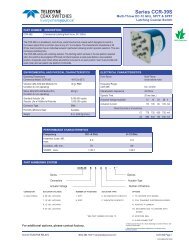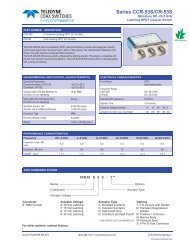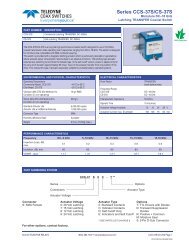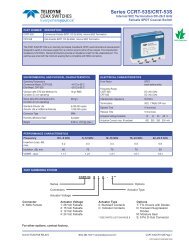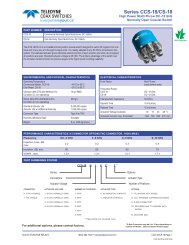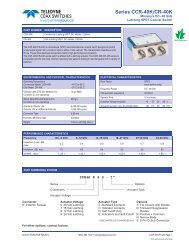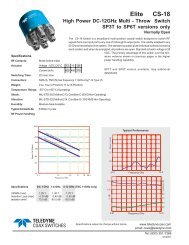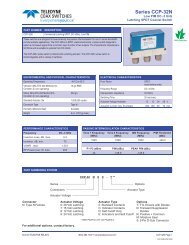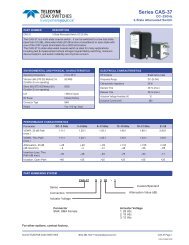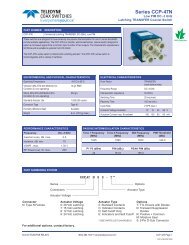Download our Space Databook - Teledyne Relays
Download our Space Databook - Teledyne Relays
Download our Space Databook - Teledyne Relays
You also want an ePaper? Increase the reach of your titles
YUMPU automatically turns print PDFs into web optimized ePapers that Google loves.
Coil<br />
A wire assembly wound around an insulating bobbin or spool.<br />
Contact arrangement<br />
The combination of contacts that make up the entire relay<br />
switching structure.<br />
Contact bounce<br />
Internally caused intermittent and undesired opening of closed contacts, or<br />
closing of open contacts.<br />
Contact bounce time<br />
The interval between fi rst make of the contact until the<br />
uncontrolled opening and closing of the contact ceases.<br />
Contact chatter<br />
The momentary opening of a closed contact due to external<br />
shock or vibration.<br />
Contact force<br />
The force exerted by a movable contact against its matching<br />
stationary contact when the contacts are closed.<br />
Contact gap<br />
The minimum distance between a moving contact and its<br />
matching stationary contact when the contacts are open.<br />
Contact Stabilization Time<br />
The interval between the fi rst closure of a contact until the contacts reach<br />
and maintain a static contact resistance state.<br />
Contact weld<br />
The fusing of contacts, resulting in their failure to open.<br />
Contacts The current-carrying parts of a relay that open or close electrical<br />
circuits.<br />
Cycle, relay<br />
One opening and one closure of a contact set. One cycle consists of two<br />
operations.<br />
Dropout voltage, specified<br />
As the voltage on an energized relay is decreased, the voltage at or above<br />
which all relay contacts must return to their deenergized positions. Not<br />
applicable to latching relays.<br />
Electromechanical relay<br />
A relay in which the motion of the contacts are dependent upon the magnetic<br />
attraction or repulsion of an armature to or from a pole face. The magnetic<br />
force is generated by a coil which may or may not incorporate suppression<br />
and/or polarity reversal protection methods.<br />
Hermetically sealed relay<br />
A relay contained within an enclosure that is sealed by welding to<br />
insure a low rate of gas leakage.<br />
Inspection lot<br />
A grouping of relays based upon their similarity in manufacturing process<br />
characteristics and screening requirements submitted for inspection at one<br />
time.<br />
Latching (bistable) relay<br />
A two-position relay whose contacts transfer only as a result of coil energization<br />
of a particular coil, remain in that position with no coil energization, and transfer<br />
to the alternate position only as a result of coil energization of the other coil.<br />
Miss<br />
Failure to establish the intended contact conditions.<br />
Glossary<br />
Neutral position<br />
An anomalous state in latching (bistable) relays normally<br />
produced by insuffi cient coil signal or simultaneous pulsing of set and reset<br />
coils. Analogous to “don’t care” condition in electronic latches. This condition<br />
is not harmful to the relay.<br />
Normal mounting means<br />
A method of mounting whereby an intended test is performed on a relay and<br />
the fi xture(s) employed adequately supports the relay and neither attenuates<br />
nor amplifi es the intended condition.<br />
Normally closed contact<br />
Those contacts that are closed with the relay de-energized. Not applicable to<br />
latching relays.<br />
Normally open contact<br />
Those contacts that are open with the relay de-energized. Not applicable to<br />
latching relays.<br />
Operate time<br />
The interval between the application of an input signal and fi rst closing of a<br />
normally open contact. Bounce time is not included.<br />
Operation, relay<br />
One opening or closure of a contact set. One relay operation is one-half of<br />
a cycle.<br />
Output<br />
The circuit within a relay which controls an external load circuit and is changed<br />
from a conducting to a non-conducting state (and vice versa) by the relay<br />
operation.<br />
Pickup voltage, specified<br />
As the current or voltage on a de-energized relay is increased, the voltage at<br />
or below which all contacts must achieve their energized positions.<br />
Polarized relay<br />
A relay, the operation of which is primarily dependent upon the direction<br />
(polarity) of the energizing current(s) and the resultant magnetic fl ux.<br />
Production lot<br />
A grouping of relays released for production as a single lot.<br />
Rated coil voltage<br />
The coil voltage at which the relay is designed to operate and meet all<br />
specifi ed electrical, mechanical and environmental requirements.<br />
Relay<br />
An electrically controlled switch.<br />
Release time<br />
The interval between the removal of an input signal and fi rst closing of a<br />
normally closed contact. Bounce time is not included. Not applicable to<br />
latching relays.<br />
Reset Voltage<br />
The voltage required to return the contacts of a latching relay from a set<br />
position to a specifi ed initial condition. There is no universally defi ned reset<br />
position.<br />
Saturation<br />
The condition attained in a magnetic material when an increase in<br />
magnetizing (coil) current produces no appreciable increase in fl ux.<br />
Set Voltage<br />
The voltage required to change the contact position of a latching relay from a<br />
specifi ed initial condition. There is no universally defi ned set position.<br />
Supply voltage<br />
The voltage s<strong>our</strong>ce that supplies power to drive the relay coil.<br />
© 2013 <strong>Teledyne</strong> Coax Switches (800) 351-7368 • www.teledynerelays.com www.teledynecoax.com • +44 (0) 1236 453124 • www.teledyne-europe.com Page 57



